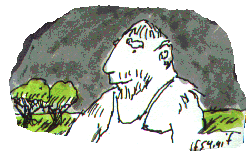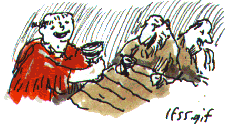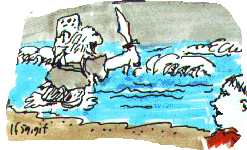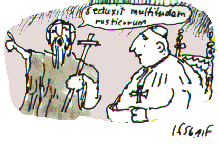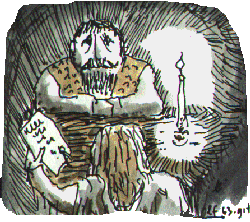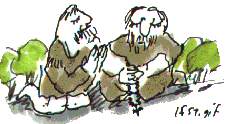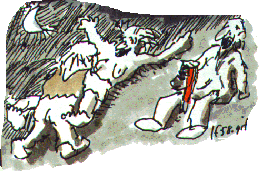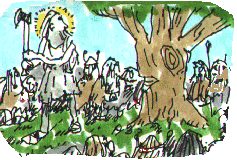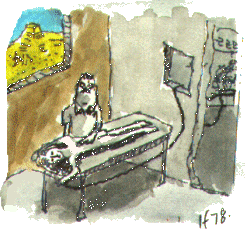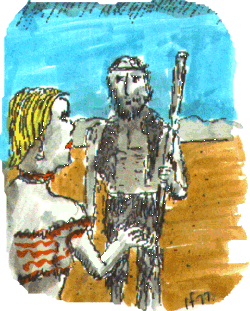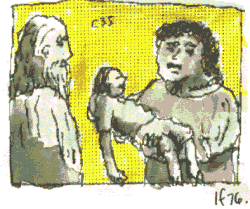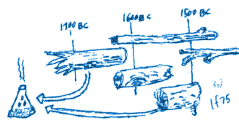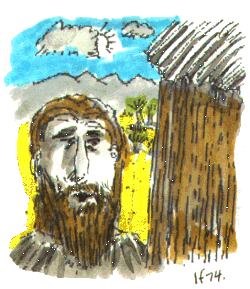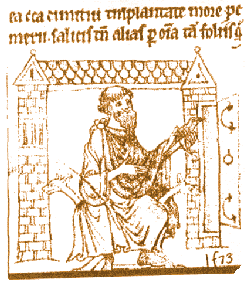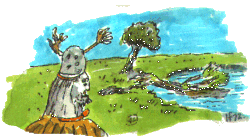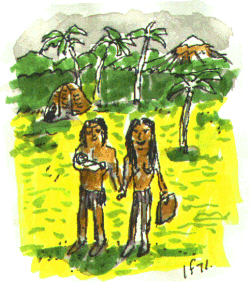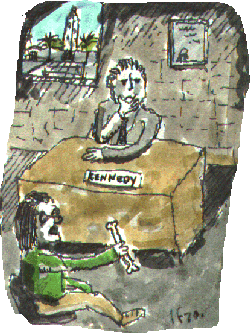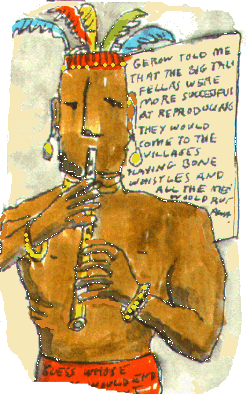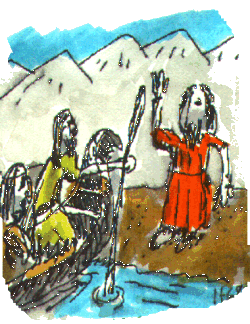oaks:0:lf52.gif:270

One of the first pieces of art that we associate with the first organized society of early bronze age is the stone relief showing the Egyptian King XXX fixing a levee. By controlling water one raised more rice than needed, saved wealth built temples, invented accounting and lawyering. Hence Mesopotamia, Egypt, New York, Sacramento.
Was all of this the invention of power hungry kings or greedy queens?
One
clue to this and other even more relevant mysteries. The Egyptians soon took to worshipping
beetles.
oaks:0:lf51.gif:268
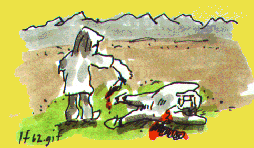
Expelled from Eden for original sin, the sons of
Adam and Eve fought jealously ending in the banishment of the agriculturalist Cain after he
murdered his pastoralist brother Abel. God's displeasure was a chronic condition; it wasn't
long before women were dating immortals, like local girls at spring training, and Yahweh was
announcing a 120 year advance warning of disaster.
oaks:0:lf62.gif:266
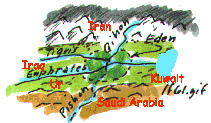
Eden (Sumerian for "plain") is sited at the
meeting point of four rivers. The Ghhon (Karum) winds through Cush (Kasbites, Iran) and the
Pishon now a dry wadi from Havilah, now Arabia. Today the junction is a vast marsh a
hundred miles inland of the Persian Gulf, inhabited by the Shiite marshland Arabs, scene of
the ancient cities of Ur, Uruk, and Eridu, and more recently site of the Gulf War.
oaks:0:lf61.gif:265
If the oak tree devastation was merely a scientific oddity, of much more lasting
significance are two other notable events that seem to center on exactly the same time: 1)
the mesolithic-neolithic transition, when the old hunter-gatherer stone age cultures (present
in Ireland for about 7000 BC - 3000 BC or four thousand years) gave way to the Neolithic
culture with it domestication of animals and agriculture. Although archaeologists have
emphasized the gradual, non-invasive roots of this change, playing down the older vision of
invasion and genocide in favor of scenarios like the spread of Thai food or wearing ones
sunglasses on top of the head (reportedly started by Audrey Hepburn in 19XX) featured in
mythology, even a contemporary scenario featured by the gradualist view seems remarkably
sudden in the longer view of matters (figure XX). 2) The start of building of "court cairns"
and "portal tombs" that dot the Irish landscape. 3) The arrival of "Celtic" (Indo-European
culture in the British isles).
Oaks bog decline:0::169
The decline in bog oaks in Ireland's peat beds was dramatically sudden. What is more, the
occurrence could well have even more catastrophic than the curve shown on figure XX suggests,
since oak trees may live several hundred years. How can such an event like this be explained?
The onset of an era of heavy rainfall would raise the water level in boggy ground, turning
bogs into year-round ponds, with the fatal impact on trees that is evident to anyone who has
seen a flooded forest. Evidently this is what happened in Ireland at about 3200 B.C. In
fact, the shortage of bog oak in the period 5150-5250 (?) anywhere in the British isles
was a problem for Bailie and his colleagues when they tried to fill the complete chronology.
Baillie himself, not shy of taking the plunge, has suggested that something dramatic may have
happened during this century.
Oaks bog decline:0::168
One internal site near Baltimore in County Cork was not discovered until 1993. So-called
"The Lag," this site is a passage tomb had has apparently stood unrecognized for thousands of
years. It is located on an island in a drowned estuary (Elizabeth Shee Twohig UCC).
Oaks lag:0::170
Bog wood, especially oak, is buried in peat throughout Ireland and has been used for full
construction for hundreds of years. The harp of a famous 18th century musician was made from
it, the better to produce tuneful echoes of Irelands past. On it was inscribed: In the time
of Noah I was green. Since his flood I have not been seen. Until seventeen hundred and two I
was found, by Cormac O'Kelly underground. He raised me up to that degree. That Queen of
Musick you may call me. (The Bogs of Ireland, Grace O'Donovan, UCC).
Oaks poem:0::171
Moreover just as the oak rediscovery of oak-based knowledge has led to a unique cross
disciplinary collaboration involving mythology, science and cultural studies (as for example,
the current work centered on the ancient Irish site of Navan) so the new chronological
sciences including are pouring new data and insights into journals, fueled in part by hints of
global climate change as we enter an unstable era in the closing years of the Holocene.
Startling findings include scientific confirmation of events that punctuated the great
religions of the world and established the fundamental set of values of the Neolithic times,
myths of creation, the Garden of Eden, a benign world in which mankind was given an
opportunity of establishing harmony with the universe. What do the oaks tell us about the
coming changes? The virtual certainty of change, the impotence of "command and control"
management programs favored by western elites, calls for the need for new religious awe and
sense of poetry, appreciation of chaos, catastrophe and fate. Case histories of an ascending
series of disasters and the imperial assumptions that led to them, illustrate how the
fundamental assumptions of specialists must be revised to enable us to cope with coming
events.
Oaks proposal:0::167
Since the time of the Greek divination by oaks has been revered as a means of prophecy,and
it is perhaps not surprising that the capacity of oaks to tell the past and future has now
received stunning scientific confirmation through the establishment of oak chronologies in
Germany and Ireland.
Oaks proposal:0::166
THE TESTIMONY OF THE OAKS: New ways of looking at earth processes (inspired in large
degree by the deciphering of oak tree ring chronologies) suggest a world of discontinuities
and "events" that is closer to traditional and pagan visions than the Victorian concepts that
underlie our traditional "management" of natural hazards. My proposed book demonstrates and
explores the implications of this trend through examination of notable and recent earthquakes,
floods, etc.
Oaks proposal:0::165
4700 BP: Establishment of agricultural culture in Mexico by this date, though recent (1997)
dating of domesticated squash indicates at least some us of agriculture as much as 4000 years
earlier.
Oaks squash, don squash:0::173
Questions or Comments?
